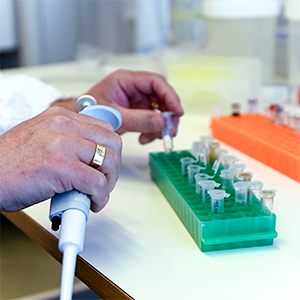Contact
 Magnus Karlsson
Magnus Karlsson
Professor in Agricultural Plant Pathology
Magnus Karlsson's CV page
Department of Forest Mycology and Plant Pathology, SLU
magnus.karlsson@slu.se, 018 -67 18 37

Several species of the fungus Clonostachys have been shown to have the potential to be used as biological control agents in a new study from SLU. Eleven fungal genomes have been sequenced and biological control against a fungus that causes foot rot and head blight in cereals have been investigated in a laboratory environment. Both reduced disease development and growth inhibition of the pathogenic fungus were noted in several isolates.
A mycoparasite is a fungus that attacks other fungi. Mycoparasitic relationships display a range from biotrophic, where nutrients are acquired from living host cells, to necrotrophic, where the fungal prey is killed and then consumed by the mycoparasite. Certain mycoparasitic strains are used as biological control agents against plant pathogenic fungi in agricultural fields. Biological control is a more sustainable and less hazardous alternative to the use of chemical pesticides.
- Of course, we want to maximize the benefits from mycoparasites in agriculture. In order to do that, we must learn more about the factors that affect what happens between the mycoparasite and the fungi that attack agricultural crops, says Magnus Karlsson.
In a new study, 11 whole fungal genomes from the mycoparasitic fungal genus Clonostachys have been examined.
– We looked at different gene families that we believe are playing a role in producing proteins that are involved in biological control.
To investigate how it worked in practice, experiments were performed where wheat seeds were covered with spores of the various fungal species. The wheat seeds were placed in moist sand together with the pathogenic fungus Fusarium graminearum. This harmful fungus gives causes foot and root rot and head blight in cereal crops. In addition to crop reduction, head blight can lead to crops being contaminated by mycotoxins.
– The tested isolates of Clonostachys fungi were found to reduce the severity of the disease caused by the Fusarium fungus. Many of the isolates also reduced the growth rate of the pathogenic fungus. This is very interesting! It is possible that some of these fungi can be used in biological control in the future. We already know that isolates of the species Clonostachys rosea can be used for biological control. But it was a surprise that so many closely related species also have that potential, says Magnus.
 Magnus Karlsson
Magnus KarlssonProfessor in Agricultural Plant Pathology
Magnus Karlsson's CV page
Department of Forest Mycology and Plant Pathology, SLU
magnus.karlsson@slu.se, 018 -67 18 37
Read the whole article ”Comparative genomics highlights the importance of drug efflux transporters during evolution of mycoparasitism in Clonostachys subgenus Bionectria (Fungi, Ascomycota, Hypocreales)” in the scientific journal Evolutionary Applications.
Läs mer om forskning kring biologisk bekämpning med svampar.